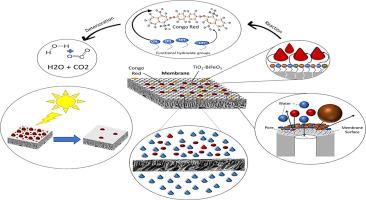A novel poly(ether-Sulfone) mixed matrix membranes infused with TiO2-BiFeO3 nanomaterials for the removal of toxic Congo red dye from textile wastewater
IF 7.1
Q1 ENGINEERING, CHEMICAL
引用次数: 0
Abstract
By modification of ultrafiltration (UF) membranes for increased water flow and enhanced antifouling qualities, this work fills a significant gap in membrane filtration. Nonsolvent-induced phase separation (NIPS) was used to create a self-cleaning polyethersulfone (PES) membrane functionalized with TiO2-BiFeO3 (TBF) nanoparticles. FTIR, contact angle, TEM, FESEM, and porosity studies were used to characterize the membrane. While retaining good dye rejection, adding 0–0.1 wt percent TBF increased pure water flow from 10 to 55 kg m-2 h-1 and enhanced wettability (25 %) and porosity (35 %). With decreased dye adsorption and pore obstruction, CR elimination rose from 80 % (pristine PES) to 94.84 %. TBF functioned as a photocatalyst in visible light, producing reactive oxygen species (ROS) that broke down contaminants and allowed for self-cleaning; after 10 h in the sun, the 0.05 wt percent TBF membrane recovered all of its flow. These findings show that PES/TBF membranes are a sustainable choice for improved membrane performance (permeability, selectivity, self-cleaning membrane characteristics include anti-fouling capabilities), effective dye treatment, and photocatalytic degradation, all of which help to safeguard the environment and provide cleaner water.

一种注入TiO2-BiFeO3纳米材料的新型聚醚-砜混合基质膜用于去除纺织废水中的有毒刚果红染料
通过对超滤(UF)膜进行改性,增加了水流量,增强了抗污染性能,填补了膜过滤的重要空白。采用非溶剂诱导相分离(NIPS)法制备了二氧化钛- bifeo3 (TBF)纳米粒子功能化聚醚砜(PES)自清洁膜。利用FTIR,接触角,TEM, FESEM和孔隙率研究对膜进行了表征。在保持良好的染料去除率的同时,添加0-0.1 wt % TBF可将纯水流量从10 kg m-2 h-1提高到55 kg m-2 h-1,并提高润湿性(25%)和孔隙率(35%)。随着染料吸附和孔隙阻塞的减少,CR去除率从80%(原始PES)上升到94.84%。TBF在可见光下作为光催化剂,产生活性氧(ROS),分解污染物并允许自清洁;在太阳下晒10小时后,0.05% TBF膜恢复了所有的流量。这些发现表明,PES/TBF膜是一种可持续的选择,可以改善膜的性能(渗透性、选择性、自清洁膜特性包括抗污染能力)、有效的染料处理和光催化降解,所有这些都有助于保护环境和提供更清洁的水。
本文章由计算机程序翻译,如有差异,请以英文原文为准。
求助全文
约1分钟内获得全文
求助全文
来源期刊

Chemical Engineering Journal Advances
Engineering-Industrial and Manufacturing Engineering
CiteScore
8.30
自引率
0.00%
发文量
213
审稿时长
26 days
 求助内容:
求助内容: 应助结果提醒方式:
应助结果提醒方式:


